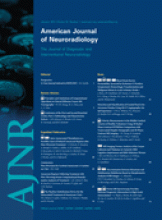Intracranial volume compensatory changes explained by the Monro-Kellie hypothesis (MKH) occur in spontaneous intracranial hypotension (SIH) and may be seen on MR imaging.1 This case illustrates previously unreported findings on postcontrast fluid-attenuated inversion recovery (FLAIR) imaging conforming to the MKH, including diffuse pachymeningeal enhancement and gadolinium diffusion into the subdural space. It also highlights an additional compensatory mechanism of subarachnoid seepage seen as gadolinium opacification of the subarachnoid space.
A 52-year-old man had a 3-year history of intermittent orthostatic headache relieved by lying down. Two years ago, he presented to the emergency department with severe headache, at which time brain CT showed bifrontal subdural hematomas, which were surgically evacuated. Following an initial asymptomatic period, his symptoms recurred after a few months. A year later, he presented again with severe headache, this time associated with nausea and vomiting. Brain MR imaging showed diffuse pachymeningeal enhancement and bilateral subdural effusions. FLAIR imaging, in addition, showed hyperintensity and thickening of the pachymeninges. Delayed postcontrast FLAIR showed diffuse pachymeningeal enhancement with gradual opacification of the subdural space followed by the subarachnoid space (Fig 1). Low opening pressure and xanthochromia were noted on lumbar puncture, with CSF showing elevated erythrocyte count, lymphocytosis, and raised protein levels. Renal function test findings were normal. In view of the patient's reluctance to undergo intervention, he was managed conservatively with bed rest, hydration, and medication. At discharge, he was asymptomatic.
A, Delayed postcontrast FLAIR image shows diffuse pachymeningeal enhancement and opacification of the subdural space with gadolinium (arrowheads). B, Delayed image shows contrast opacifying the subarachnoid sulcal spaces (arrows).
While postcontrast FLAIR has been useful in various intracranial lesions, its role in SIH has not been studied. The first of our findings on postcontrast FLAIR was diffuse pachymeningeal enhancement, similar to that described on postcontrast T1-weighted images. The mild T1 effect of postcontrast FLAIR allows detection of the increased contrast concentration in the engorged veins and interstitium in the dural border cell layer in SIH.2 If the pachymeningeal venous dilation alone is not sufficient to compensate for the CSF loss, fluid extravasation persists and leads to subdural effusions.3 Our second finding following pachymeningeal enhancement was gadolinium diffusion into the subdural space with maximal subdural space opacification corresponding to the site of greatest pachymeningeal thickening and subdural effusions, a finding conforming to the MKH. Our third finding on delayed FLAIR was contrast opacification of the subarachnoid space. We hypothesize that this finding of gadolinium gradually opacifying the subarachnoid space suggests increased permeability, which comes into play in ongoing CSF loss when other mechanisms are saturated. This theory is further supported by frequent findings of increased red blood cells and raised protein levels in the CSF and previous reports of increased red blood cell diapedesis with subsequent subarachnoid hemorrhage in SIH.4
A combination of pachymeningeal enhancement followed by subdural and subarachnoid space opacification, we believe, is specific to SIH and may aid in diagnosis in atypical cases, including those with subarachnoid hemorrhage. Also, these findings represent progressive compensatory mechanisms, with subarachnoid seepage appearing when the CSF leak persists and compensation has been inadequate. The latter of these findings (ie, subarachnoid space seepage), therefore, may also suggest near saturation of compensatory mechanisms and may indicate poor response to treatment, especially conservative treatment. Further studies to ascertain the role of such late imaging findings in SIH are suggested.
- Copyright © American Society of Neuroradiology








